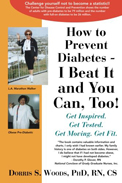
 |
Dorris Woods was looking forward to visiting family for a holiday break but knew she shouldn’t skip her appointment with Dr. Davis, her endocrinologist. She was not prepared for the news her doctor would give her, and it left her shocked. Davis revealed that Woods was borderline diabetic. As a nurse and educator, Woods initially didn’t want to believe it. The diagnosis put her into a mild depression, but she began watching what she ate over the holiday and lost a couple of pounds. When the holiday was over, Woods met with her dietician. She decided to learn all she could about diabetes, diet, exercise, the medications involved, and the psychology of the disease. Gathering resources from various health professionals, scholars, and medical journals, Woods began building a plan to get herself to a healthy weight while making moderate, routine exercise a habit. Once she had a plan in place, Woods set out to chronicle her journey against diabetes.
Most major illnesses have a plethora of books covering them from multiple perspectives. With ongoing research and medical advances, these books often need to be replaced with newer ones with the current and best-researched information and practices. In her book, Woods writes about what has worked for her and what she has struggled with. She includes several appendixes with additional information pertinent to others who find themselves in a similar health scenario. However, what sets the author's book apart from the pack is the inspiring personal narrative. Woods gives readers a conversational style book, which is more about her journey and how it could also benefit a reader rather than a deep scientific dive into the disease. She details some of the information that she found beneficial and includes other research information in her appendices. The kind of information she shares is similar to what a reader might expect in Mark Hyman’s The Blood Sugar Solution or Neal Barnard’s Dr. Neal Barnard’s Program for Reversing Diabetes. Both of these books deal with the disease but have a narrower focus honed in on preventing or reducing the effects of diabetes on the patient. While valuable resources in their own right, they lack the personal story effect of this book.
The first thing that comes to mind when reading Woods' work is how comfortable the author feels telling her story and how easy the presentation is for her. The writing style is simple and conversational, making for an easy read. Woods is optimistic, and that comes through in her writing, allowing the book to also help motivate the reader who may be on a similar journey. A reader fairly new to diabetes who is looking for as much information as possible will find this book serves as a good companion volume, as this is more of a purchase after someone has a handle on understanding diabetes and is ready for a more personal, inspirational type of book to jolt them into acting on their diabetic and/or pre-diabetic care. Woods also offers an extensive list of resources to help the reader find the specific information they may be seeking. This book will be a nice addition to a personal library on the disease, and it is surely a more pleasurable read than many that are out there.